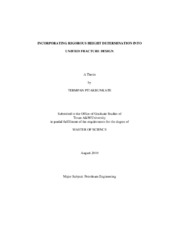| dc.description.abstract | Hydraulic fracturing plays an important role in increasing production rate in tight
reservoirs. The performance of the reservoir after fracturing can be observed from the
productivity index. This parameter is dependent on the fracture geometry; height, length
and width.
Unified fracture design (UFD) offers a method to determine the fracture
dimensions providing the maximum productivity index for a specific proppant amount.
Then, in order to achieve the maximum productivity index, the treatment schedules
including the amount of liquid and proppant used for each stage must be determined
according to the fracture dimensions obtained from the UFD.
The proppant number is necessary for determining the fracture geometry using
the UFD. This number is used to find the maximum productivity index for a given
proppant amount. Then, the dimensionless fracture conductivity index corresponding to
the maximum productivity index can be computed. The penetration ration, the fracture
length, and the propped fracture width can be computed from the dimensionless fracture
conductivity. However, calculating the proppant number used in UFD requires the fracture height as an input. The most convenient way to estimate fracture height to input
to the UFD is to assume that the fracture height is restricted by stress contrast between
the pay zone and over and under-lying layers. In other words, the fracture height is
assumed to be constant, independent of net pressure and equal to the thickness of the
layer which has the least minimum principal stress. However, in reality, the fracture may
grow out from the target formation and the height of fracture is dependent on the net
pressure during the treatment. Therefore, it is necessary to couple determination of the
fracture height with determination of the other fracture parameters.
In this research, equilibrium height theory is applied to rigorously determine the
height of fracture. Solving the problem iteratively, it is possible to incorporate the
rigorous fracture height determination into the unified fracture design. | en |


